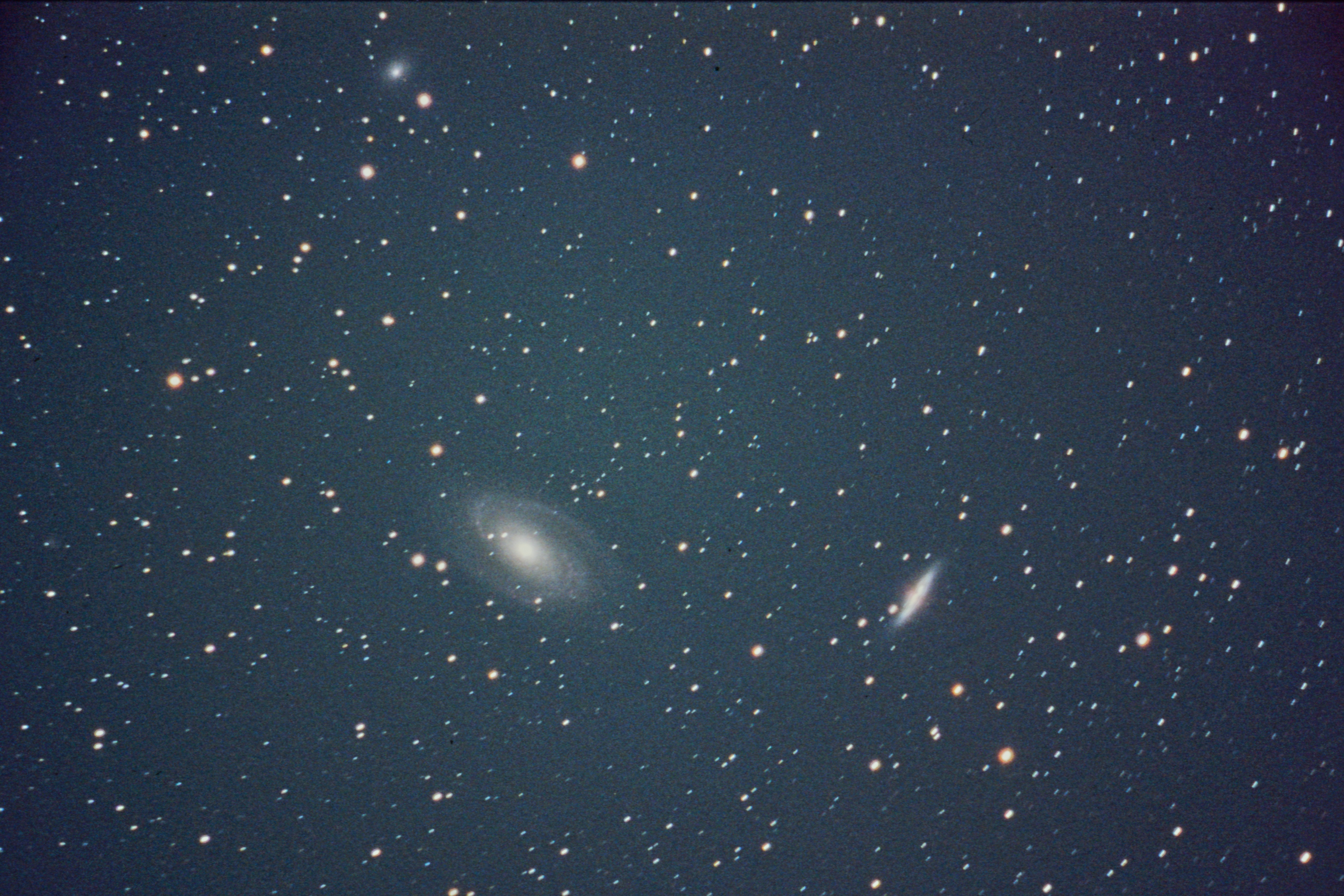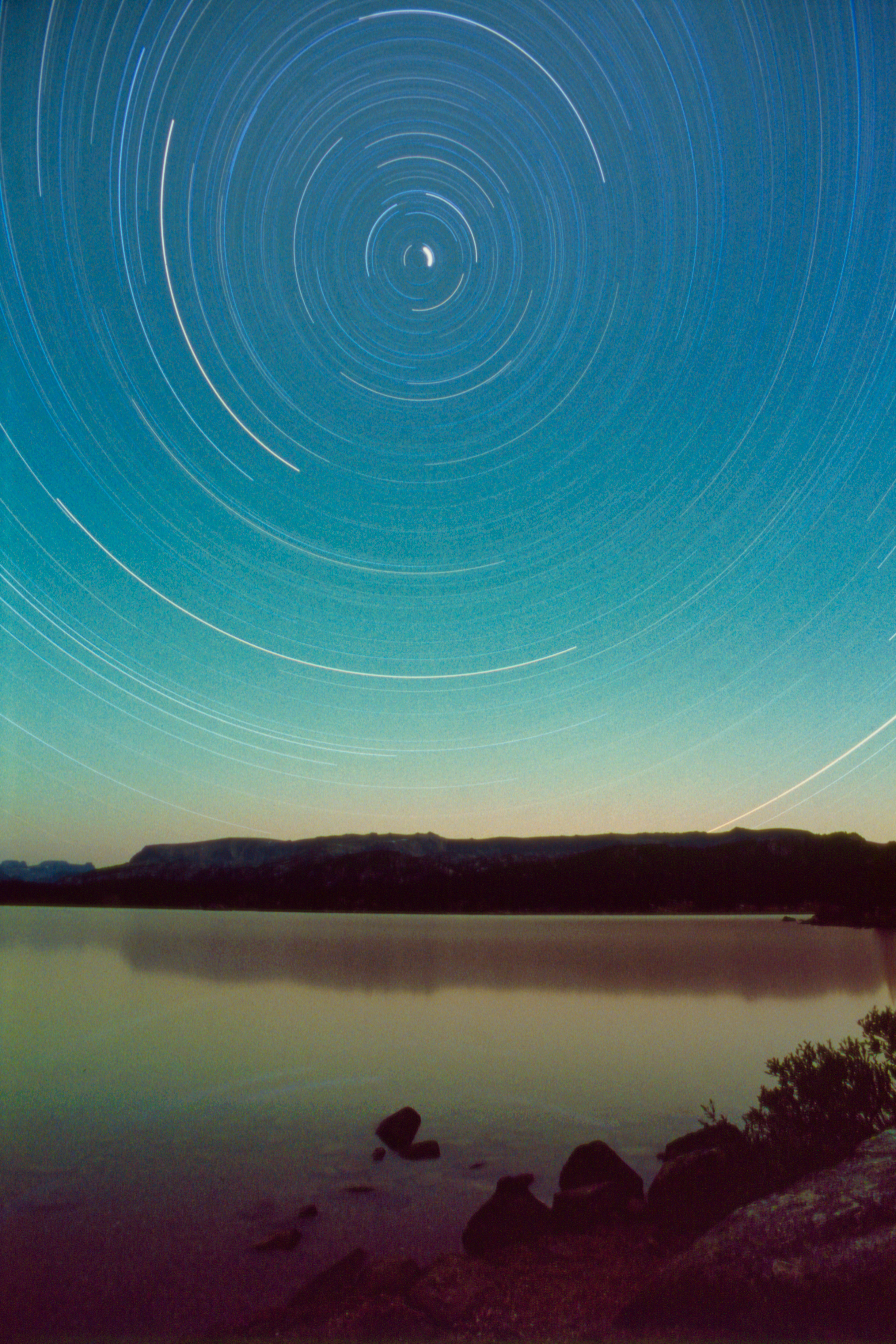Mike eventually left me to the finicky procedure of finding the focus. It took another thirty minutes by the time I was satisfied. I had several targets I wanted to shoot this night, and the first one was M80 and M81, a pair of galaxies that could fit in a single view, faint swirls of light framed by the foreground stars of the Big Dipper. I attached the camera back, connected the cable release, started my timer, held my breath, and tripped the shutter. It was midnight, and I was catching my first photons!
I now had a moment to break from my equipment-demanded trance. From my position at the top of the boat ramp, I had a great view of the lake, its island silhouetted in the surround of the mirrored sky. At the shore I could make out my fixed camera tripods, a small indicator light showing the nearby battery packs powering the dew heaters that kept the lens clear from condensation. All of my film was now open to the sky, each exposed frame collecting the faint trickle of photons gathered by lenses and mirrors.
There was nothing for me to do! I gazed across the lake in a state of unexpected idleness. I wondered what my cameras at the lake were recording. I had intended to leave them open all night, but now that the lake surface was so calm, should I start over? I started to mentally compose other shots. I could reposition the cameras. Should I? Or should I do something else, like change the lens aperture? Or should I just re-shoot the scene with the exact same settings, trying to build insurance that one of the frames will turn out?
The lake was now at last a mirror, but I noticed that it was not so everywhere. Even though there was no moon, I could see rough spots in the glass that could not reflect the pinpoint stars, but did reflect the general starlight averaged from everywhere overhead. These patches would grow and shrink and drift across the lake as tiny breaths of air would tickle the surface into wavelets. I wondered what this effect was having on my long exposures of this scene. I worried that the air motions would get larger, maybe engulfing the entire lake with the frosted appearance.
A mind left to wander can go down many paths. Mine was pulled back from this road of worry by the raspy, digitally feminine voice of my talking timer, announcing that I had “five minutes… remaining”. The film at my telescope’s prime focus was nearing the end of its exposure time. The talking timer is a gadget I had first learned about from a seasoned member of my astronomy club. In one of our meetings, he described some of the things that he found helpful in taking astrophotos. And indeed, as soon as he mentioned it, I knew that this would be a great improvement over the visual inspection of my watch, or some other timekeeping device.
The problem is that at the end of an exposure your hands are busy with several things: specifically a large cardboard “shutter” that will get positioned over the front of the telescope to block more light from entering, and the camera cable release, to close the shutter immediately in front of the film. Without touching the telescope, the cardboard is used to block its entrance, then the camera shutter is closed. All this, just to avoid any slight vibration that could jiggle the stream of photons and mar the exposure. The maneuver is called the “hat trick” and yes, it is often done with an actual hat. The delicacy of this end-movement is threatened if, in addition to hat and cable, I try to also juggle a flashlight and stopwatch to initiate the sequence on schedule. A countdown timer that could announce to me from anywhere in the dark that the moment had come was the perfect answer.
This is just one more of those curious items that confirm the behavior of an astrophotographer as being almost bizarre to innocent observers. Even other amateur astronomers, engaged in the visual pursuit of the sky, when setup within hearing distance, will wonder what is going on. The benefits of this gadget are so important to me however, that I am willing to put up with the odd comments of bystanders. In fact, over time I have come to enjoy the synthetic company of its voice as it marks the minutes in the dark.
On this night, my first deep sky exposure lasted thirty minutes. I made another to try to increase the likelihood that one of them would turn out, and then changed the aim of my telescope. The night was cool, the calm air preventing it from being labeled as cold. As long as the conditions held, there was no reason for me to stop; I found my next target, the Helix Nebula, and went through the effort of focusing again. The film back was reattached, and another pair of exposures ensued. The procedure was becoming familiar. The timer announced the ending minutes of each; I finished the shot and then started the next. For me, this was becoming a highly productive evening. I could not know of course whether any of them were successful, but just completing the mechanics was noteworthy.

Note from the future: with the availability of modern digital cameras operated by talented astrophotographers, there are much nicer photographs available of this galaxy group. See for example, https://www.skyatnightmagazine.com/news/m81m82-ngc3077/ and https://skyandtelescope.org/online-gallery/interacting-galaxies-in-ursa-major-m81-m82-ngc-3077/
In the meantime, my cameras at the shoreline continued their task of gathering the night’s starlight. The wind patches on the lake would build and shrink, but this was beyond any control I could exert. Mine was to simply record what was there to record.
In addition to my all-night startrail exposures, I tried a series of pictures at lakeside that were intended to be static night shots. I wanted the feeling of point-like stars and their reflections (rather than startrail arcs), and to this end I loaded a high-speed color negative film in one of my cameras. I intended to push-process its speed even further. A wide-angle shot could tolerate 15 to 30 second exposures without the stars turning into sausage-like smears, and so I tried various compositions. I would later find that these film frames were entirely empty, with no apparent image content, a disappointing lesson in selecting not only the proper film speed, but also a film type that did not suffer from ineffective time exposure characteristics (reciprocity law failure).
Eventually the tiny puffs of air became a tiny but steady flow, and I watched the glass of the lake become frosted everywhere. The breeze, however light, also registered on my skin the distinct temperature drop that had occurred while I was busy tending cameras and telescopes through the night. The core of the Milky Way had set, with new replacement stars arriving from the east. I was seeing a future season of stargazing above me, and it was now time to pack up and go home. When the telescopes were placed in their travel containers, the tripods collapsed, and the last of my cameras put away, I started my car and eased away from the boat ramp. With the defroster desperately clearing the windshield, I glanced in my mirror to the reflections of the sky in the lake behind me, then quietly headed out to the empty road. It was still hours before actual dawn, but the depths of the sky’s faintest stars were becoming lost as I pulled in next to my tent. Regardless of whether I had captured on film the emotions from my long past experience at Beartooth Pass, I had a new set of memories formed that night, of the pleasures of communing with the deep sky at the Top of the World.



Pingback: 9.6 Sharing the Night, Part 2 | Thor's Life-Notes
Pingback: 10 Traversing Wyoming | Thor's Life-Notes
Will you be taking shots of Jupiter/Saturn when they are the nearest since the Middle Ages?